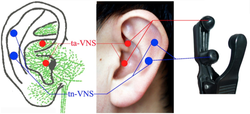 As I was helping to interpret for the Q&A sessions at the workshop this morning, I had time to carefully go over the powerpoint presentations before the workshop. Of the four presentations, the one that really caught my attention was delivered by Jing Xianghong of the Chinese Academy of Chinese Medical Science. She took us from laboratory research - experimentation with epilepsy rat models - to a clinical study on patients suffering from severe epilepsy, and during the Q&A session mentioned that her hospital is currently using their new technique as an alternative to invasive VNS device implantation. The starting point was an explanation of how vagus nerve stimulation (VNS) is able to reduce the frequency or severity of epileptic seizures through direct electrical stimulation of the vagus nerve. She then explained that, like most other cranial nerves, there are no surface areas of the torso that are innervated by the vagus nerve. However, there is an auricular branch of the vagus nerve (the ABVN), which can be stimulated through the skin in the external auditory canal (and, apparently, the auricular concha - the area of the ear associated with the internal organs in the 'inverted fetus' microcosm image). From this, Prof. Jing presented their epilepsy rat model showing that electrical stimulation of this area of the ear was effective in controlling epileptic discharge. With this evidence, they went ahead with a 50 subject clinical pilot study where the patients, all of whom suffered from refractory (i.e. not controlled by medication) seizures, had the area of the ear innervated by the vagus nerve stimulated using a small electronic device. This stimulation was done twice a day for 30 minutes each time, and was able to bring about a significant clinical effect in controlling their seizures. (it was more complicated than that, but I don't want to go into that here...) Next was a larger study with 144 patients that also showed a significant effect. One of the audience members asked if she had done a direct comparison between this auricular stimulation and conventional VNS, and Prof. Jing responded that they had not compared these two directly, but that in her hospital in Beijing they now use this device in an experimental fashion for every patient who has been referred for VNS device implantation, and that many patients were able to become seizure-free just by doing this external stimulation twice a day, and were thus able to avoid an expensive and potentially risky operation. A great example of translational (ie from 'bench' to 'bed') research!
4 Comments
Yi-Li Wu
4/18/2013 11:37:09 am
Fascinating account, Henry, and very heartening! Any time one can avoid an operation or minimize medical intervention, it's good news. Presumably people can just apply the ear stimulator while doing other things like watching TV--that 1/2 hour would just fly by :-)
Reply
Henry
4/18/2013 06:01:44 pm
Doesn't sound too stressful, eh? She mentioned at the end that it was useful for a number of other conditions as well. Here is a link to another study by the same group comparing VNS and ta-VNS: http://www.ncbi.nlm.nih.gov/pubmed/23346208 (full-text article)
Reply
Ray Powers
4/2/2016 04:00:56 am
Is there any update on the original article?
Reply
Henry
11/30/2016 01:01:07 pm
There is an ongoing study using this device in the treatment of epilepsy in children: https://www.ncbi.nlm.nih.gov/pmc/articles/PMC4546033/
Reply
Your comment will be posted after it is approved.
Leave a Reply. |
AuthorPractitioner, Translator, Teacher Archives
March 2021
Categories |
 RSS Feed
RSS Feed